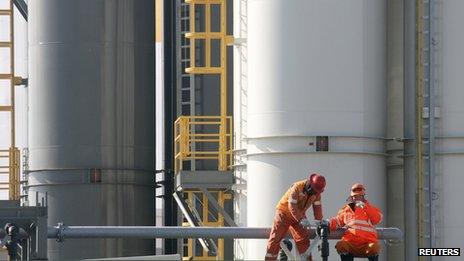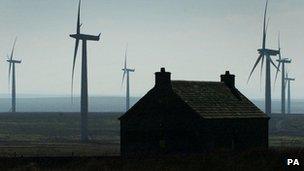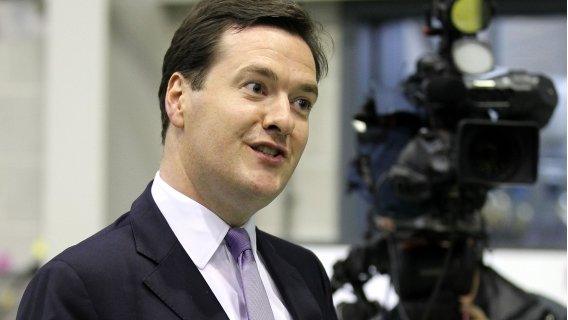2012: A year of energy
- Published

Energy will form a key part of the economic outlook and political debate
Looking back at the year, two things stand out. One has been the bumpy, uncertain course of the continued downturn, and a growing realisation that it's got a lot more bumping to do. The other has been a lot of activity in the energy sector.
The news keeps coming, and apart from your household bills, most of it has been pretty good.
Today, we learn from Norway that Statoil is committing at least £4.3bn to developing the Mariner field.
While the platform's to be built in Korea, it means sub-contracts and 700 UK jobs.
The field was first discovered 31 years ago, but only now does the subsea technology and the finance look ripe for the biggest UK offshore investment in more than a decade.
On Thursday, it was 400 jobs in Easter Ross, as Global Energy's regeneration of Nigg fabrication yard moves up a gear or two. Although it's well positioned for renewables, those jobs are more about oil and gas.
Earlier this week, Dana Petroleum announced it's going ahead as lead developer of the Western Isles field, Barra and Harris (confusingly located east of Shetland), meaning investment of about £1bn.
Today, there's also a big investment by Japanese energy firm JX Nippon, buying Eni's stakes in at least 20 fields on the so-called UK Continental Shelf (UKCS).
That includes nearly a third of the Mariner field, on track to become one of Britain's biggest producers.
And that follows days after BP's sale of more than a billion pounds-worth of assets in the North Sea - a big chunk going to Abu Dhabi-owned Taqa, and a smaller interest to SSE.
Chasing assets
What's going right? Well, there's a lot of money chasing assets. SSE and JX Nippon are among those integrated energy firms that want to secure their upstream resource.
That's what's brought a lot of Chinese money into the North Sea this year: Talisman recently confirmed it's forming a joint venture with Sinopec, and Canada's just given the green light to CNOOC's takeover of Nexen, including its big North Sea assets.
The need to grab assets where you can is partly because an increasing share of the world's oil and gas is locked up by sovereign producers, or overseen by less stable political regimes.
This investment activity has not been lost on those arguing for Scottish independence, saying this runs counter to warnings that investment could dry up because of constitutional uncertainty.
If it proves anything, it is that this is one sector where the industry assumes the outcome of Scotland's constitutional debate will not do much to change the course of the fiscal and regulatory regime that currently exists in UK waters.
It is also because the UK fiscal regime is looking less unstable than it was. After repeated Treasury raids, the last one - in George Osborne's 2011 Budget - led to howls of protest from the industry, and some sharp responses in reduced investment.
Facing ferocious lobbying, the Treasury has engaged its reverse gear and opened up a series of targeted field allowances to make investment more attractive.
The government's also moving to sort out one of the big clouds that hangs over the industry: who is responsible for the costs of de-commissioning offshore equipment. That latter measure is being directly linked to the Japanese decision to buy from Italy's Eni.
But all that underlines one factor worth bearing in mind about the future of the industry: to create incentives for energy firms to invest in hard-to-reach reserves, the industry's going to expect bigger tax breaks. So governments will get less revenue.

Renewables are now a key part of the energy landscape
Golden twilight
With investment flowing again, does that mean we can assume the production taps are getting turned on again, and British/Scottish waters can look forward to decades of a prolonged golden twilight for the industry?
Not so fast. The price of oil, on which investment and tax revenue depends heavily, has always been volatile. Now production has joined it.
It was assumed that UKCS production would decline at about 5% per year. That was until 2011, when it fell off a cliff. Gas production declined 21% in one year, and oil was down 17%.
Much of that was due to unexpected maintenance shutdowns. It was a reminder, of course, that old equipment leads to the unexpected becoming more of a feature, and that production estimates are no longer to be trusted.
So the Treasury and the Office of Budget Responsibility (OBR) have downgraded their estimates of where revenue is heading.
They did so just ahead of one of the gloomier oil economists, Inverness-based Tony Mackay, noting a modest bounce-back in production this year. He points to August's figures, with oil production up nearly 2% on August 2011, and gas up 3%.
Declining deficit
Applied to the spreadsheets beloved of the Centre for Public Policy for Regions, at Glasgow University, the Treasury and OBR estimates point to a different trajectory for Scotland's notional deficit. That, of course, plays a prominent part in the independence referendum campaign.
Including a geographic share of oil, it looks like an independent Scotland could look to its relatively strong position (that is, a smaller deficit than the UK) lasting only until next financial year. After meeting at 6% of the UK's/Scotland's GDP, the Scottish deficit would then decline more slowly than that of the UK.
By this reckoning, austerity is on track to take the UK deficit down to 1.6% of GDP by 2017-18, while the Scottish deficit (applying similar austerity measures) would be at 3.5% by that year.
Where's our oil fund?
CPPR underlines the consensus that now exists around the case for an oil and gas revenue fund, and the regret that the Treasury in London has used the offshore energy revenue for current expenditure.
Where is our Norway-style oil fund, ask nationalists? It may be a rhetorical question, but let's spell out the answer: the money paid in the 1980s for the high cost of unemployment and of the massive transition away from old industries. It was then used to keep taxes lower than they would otherwise have been.
If you're of a neo-liberal economic outlook, keeping taxes down was the most efficient use for all that money. If you're not, it probably looks like a prime example of short-termism and a huge wasted opportunity.
Either way, both the UK Treasury and those who look to an independent Scottish one are tied into the need for the oil revenue to keep funding current spending. Without it, CPPR says Scotland would be running a £16.6bn deficit this year, or 13% of GDP.
Turbine trends
Let's not forget Scotland's energy story in 2012 has also featured lots more in renewable power. With more wind blowing this year than last, and with more turbines being plugged into the grid, we learned today that production in 2011 reached 36% of Scotland's electricity needs.
Note: that's spread over a year. Because it's intermittent, there were times when it was producing very little of Scotland's needs. When the wind blows, it gets exported - in total, 26% of it - but there's still a need to ensure a baseload, either in Scotland or at the other end of a high-capacity grid connection.
Up to September this year, the Whitehall departmental figures point to a 15% increase in Scotland's renewable output. And that's with plans being put in place to treble capacity.
Today has seen two lending deals announced by the new Green Investment Bank, headquartered in Edinburgh. That's been set up by the UK government because of doubts that the private sector has confidence to put the necessary finance in place to meet big renewable targets. If it can, in 2013 and beyond, stand by for a lot more turbines.
You can also comment or follow Douglas Fraser on Twitter: @BBCDouglsFraser
- Published6 September 2012

- Published10 June 2012

- Published3 February 2012
